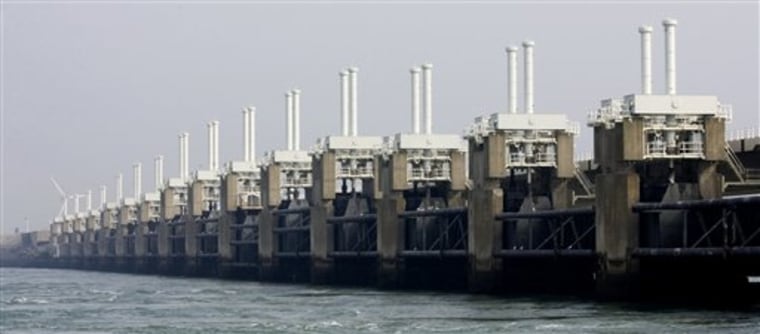With two-thirds of the Dutch population living below sea level, the country's government sees the risk of rising seas caused by global warming as a matter of life and death. So it's taking a long term view of the problem — a two hundred-year view, to be exact.
The Cabinet announced plans last Friday for a new commission to begin preparing water defenses through the year 2200.
"We want to make sure that there's still a Netherlands a century from now," Tineke Huizinga, the country's top water official, told state broadcaster NOS. "We don't want to just let the water flow and all have to move to Germany."
The Union of Dutch Municipal Governments welcomed the news, even though the plans will likely lead to new taxes, calling it a "necessity for the Netherlands to prepare for the consequences of possible climate change and to approach it, in the case of water, primarily from a safety standpoint."
"We agree that in this light, we have to hold reckoning with extreme scenarios ... it's important to understand what level of (flooding) risk is acceptable."
The Netherlands' political history and even its name, which means the "lowlands," have been shaped by its location at the delta created by the Rhine and other major European rivers.
The country is in a constant state of constructing and reconstructing its sea and river dikes, and evaluating and re-evaluating the their safety.
$20 billion over 20 years
In December, the government approved a $20 billion increase in spending on water defenses and water quality improvements over the next 20 years.
That was on top of $4 billion in extra projects already in the works this decade against the threat from river floods, as Dutch climate models predict global warming will lead to more abrupt showers in the Rhine catchment area, whose water ultimately funnels through the Netherlands on its way out to the sea.
The country also spends $680 million annually on maintaining its intricate existing system of sea and river dikes that have been built and improved for a millennium.
"I don't want to scare people. Our safety is guaranteed for the coming 50 years, insofar as it can ever be ... we spend a lot of money to make sure everything is really in order," Huizinga said. "But we know that the sea levels are rising, and that's going to demand other solutions."
Dutch policymakers are figuring on a rise in sea level of around 30 inches in the coming century regardless of the ongoing scientific debate on the causes and likely impact of global warming.
Strategies introduced in the last decade include pumping sand into strategic offshore locations where currents in the North Sea sweep them into place, bulking up dunes; re-establishing minor waterways and canals to allow the country to absorb sudden influxes of water; and designating zones for intentional flooding in an emergency.
Harder after 5-foot sea rise
Engineers believe these sorts of alterations will work up until about 5-foot rise in sea levels. Then solutions become much more difficult, especially at spots where rivers meet the sea — water now released through sluices at low tide cannot be pumped uphill.
Some more longterm ideas include altering the course of the Rhine so that its water travels along a more gradual slope toward the sea; or creating "breaker islands" off the country's North Sea coast as a possible defense against a storm surge.
One such surge in 1953 drove water near the Dutch coast more than 13 feet above normal levels, breaching defenses and killing more than 1,800 people — the Netherlands' "Katrina" moment.
The country then also established a commission similar to the one announced by Huizinga on Friday, which eventually undertook a massive 40-year building project that made the country's water defenses among the strongest in the world.
But the damage caused by Hurricane Katrina also spurred the Dutch into a new round of reflection and preparations, including drawing up worst-case scenario plans for evacuations — unthinkable politically just a few years ago.
In a statement, the Cabinet said the new commission would "put forward advice by next year on how to sustainably develop the coastline." The commission's chief is to be named later this month.
